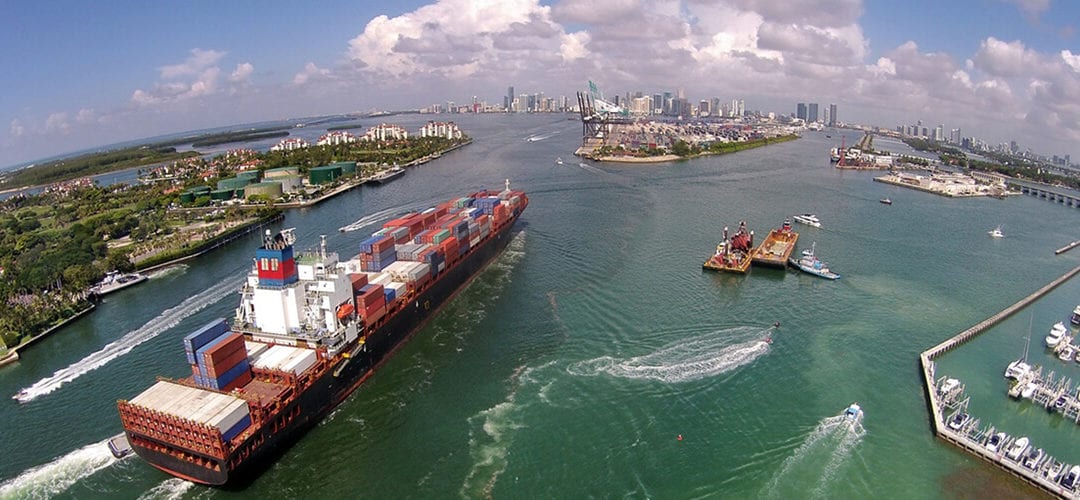Although most blooms imported into the United States are transported by cargo plane, transporting cut flowers by sea freight has dramatically increased in the last four years.
From just 200 stems coming through PortMiami in 2015 to 26.8 million stems in 2018, the numbers keep going up. In January 2019 alone, 14.3 million stems were processed through Miami, according to port records.
“The practice of transporting cut flowers by sea is increasing dramatically and could become as common as air transport in the future.”
This overview will get you up to date on the process And the numbers keep going up.
Almost two-thirds of fresh flowers sold in the United States are from imports, and about 80 percent of imported flowers come through Miami. Imported stems that arrived by freighter in 2018 originated from six countries: Costa Rica, Mexico, Peru, Columbia, Guatemala and Ecuador, with the latter three shipping the bulk of stems to the United States.
Nearly 60 percent of floral shipments into the United States last year were roses, with Chamaedorea (cut palm), Dianthus and mixed bouquets the next largest in terms of total quantity arriving by sea.
In the past, the highly perishable nature of cut flowers and travel distance made air transportation the mode of choice for producers looking for speed to market. The shift from airfreight to sea transport began in September 2017, when Hurricane Irma left a swath of destruction from the Caribbean to the Carolinas, causing upheaval of power and transportation infrastructures.
A ripple effect took place that led to limited availability of airfreight and subsequent cost increases for air transport. The result? Rising tides for transporting cut flowers by sea. While seaborne trade continues to expand, primarily because of competitive freight costs, there are pros and cons that influence which mode of transport to use.
An obvious drawback of sea shipping is longer transit time. It can take 23 or more days to go from harvest to store via sea, depending on efficiencies, country of origin and destination.
By far the most important factor for maintaining the quality of harvested flowers is maintaining cold-chain storage. That means flowers are cooled as soon as possible after harvest and that optimum temperatures are maintained during distribution. Blooms transported by sea are near-frozen shortly after harvest and kept that way for up to two weeks as they make the journey by ship in refrigerated containers.
Some flower varieties are robust enough that quality is not altered; however, some varieties are too delicate to travel by sea. Airfreight will, therefore, continue to be used because of seasonality and specific market demands. The reason: speed, speed, speed. It’s estimated, however, that as much as 30 percent of all cut-floral shipments can be done by sea freight.
Improved technologies and supply-chain management for transporting by air, sea and truck have the potential not only to improve the quality of floral product but also to generate growth for the entire the floral industry. Success will take continued collaboration throughout the supply chain, including producers, shippers, carriers, consignees and retailers.
To that end, Produce Marketing Association (PMA) hosted a “Floral Transportation Town Hall” in Miami, in February 2018, to share information, review trends and data, and provide a forum for discussion. We tackled the transportation and supply-chain topic further at “Fresh Connections: Floral Miami” in May 2018, where participants identified innovation, education and collaboration as key ingredients for overcoming transport challenges.
Deeper discussions took place in October at one of PMA’s experience extensions at Fresh Summit titled “Transportation in Floral: Discuss Changes for Efficiencies.” PMA also formed a Floral Transportation Task Force in October to help identify opportunities and overcome challenges that impact the global floral industry when transporting product.
These connections and conversations have been key to identify pain points and ways we can improve. Through this work, we’ve identified box standardization, investigating the infrastructure at various ports, and developing a business case for consolidation of floral shipments as priority needs.
PMA is currently working with Christine Boldt, executive vice-president of the Association of Floral Importers of Florida (AFIF), to develop box standards for shipping floral products by air, sea and ground, for both wet and dry pack. The guidelines are expected to be released in December. Once finalized, PMA and AFIF will share the guidelines with their respective members and will encourage adoption of standards across the floral supply chain to improve care and handling of product; airflow; and palletizing for transport by air, sea and truck.
This collaborative effort, along with the work of our task force and PMA’s Floral Council, is a perfect example of how we can work together to improve processes, technologies and practices to help our industry grow.


Becky Roberts is director of Floral & New Initiatives at the Produce Marketing Association (PMA). For more information about PMA membership, floral events, or the work of the Floral Council and PMA’s Floral Transportation Task Force, contact her via email at broberts@pma.com.







